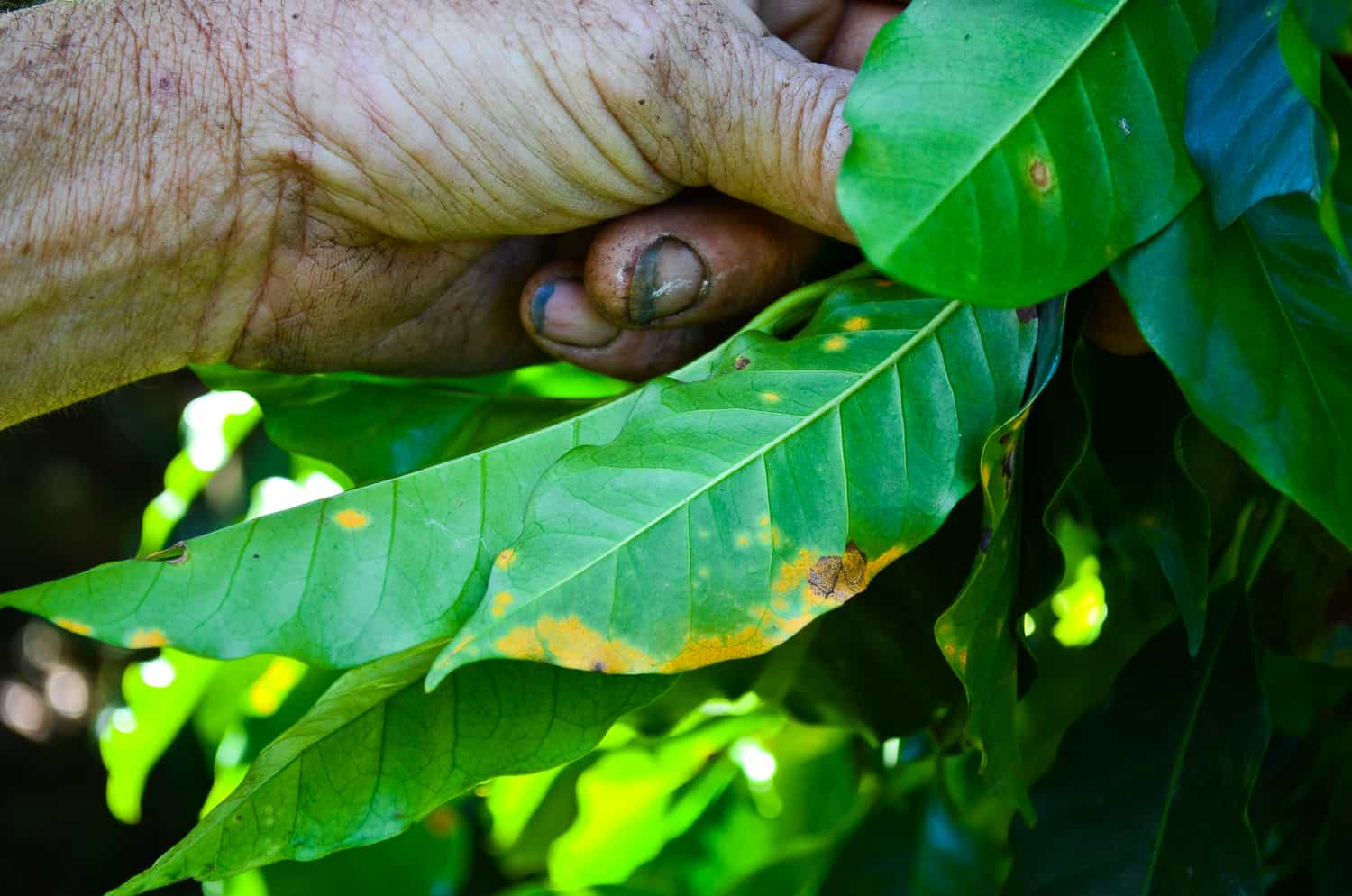At first glance, the ochre blotches on the waxy green leaves of a coffee tree appear more like a mild-mannered sunspot than a fungus that has ravaged Central America’s acclaimed coffee industry. Leaf rust, or “la roya” in Spanish, has been making waves since January, when Costa Rica and several other countries declared national coffee emergencies because of the fungus.
Nearly 50 percent of coffee plantations have been infected with the fungus in the region, where nearly 2 million mostly small farmers make their living from coffee, according to a report from the International Coffee Organization. The same report estimates that upwards of 64 percent of Costa Rica’s coffee-growing regions are suffering from leaf rust damage.
While conventional coffee growers struggle with the devastating fungus, organic farmers face a unique challenge. Organic farmers in Costa Rica are working to find sustainable solutions to coexisting with leaf rust, Hemileia vastatrix, but there are few organic options to treat roya when it strikes beyond copper sulfate fungicide and a prayer.
“There are no silver bullets when it comes to leaf rust and organic farmers have even fewer options,” said Pam Kahl, a representative from Sustainable Harvest, a U.S. coffee importer based in Portland, Oregon, who runs the Roya Recovery Project.
Prevention vs. reaction
The fungus spreads through direct contact. Once infected, the plant’s leaves dry out and its coffee cherries fail to mature properly. Farmers must prune back all the infected parts of the plant to attempt to save the rest of the tree and prevent the fungus’ progression. Large monoculture coffee plantations are especially vulnerable to roya.
So far, MAG has been providing organic coffee farmers with an approved copper sulfate fungicide but several sources interviews for this story agreed that it is not a long-term solution, according to Luis Zamora, national coffee manager for Costa Rica’s Agriculture and Livestock Ministry (MAG). He noted that any fungicide or pesticide, regardless of its organic seal of approval, should be used sparingly and with great care so as not to contaminate nearby water sources.
Organic coffee’s ethos, however, might be its greatest defense against the spread of leaf rust. “Organic farming is more about anticipating problems than reacting to them,” said Julio César Chacón, who works at Las Lajas organic coffee farm in Sabanilla, Alajuela. “It’s a question of improving the soil and creating ideal conditions for the plant so that it can better resist diseases like leaf rust.”
Chacón opined that organic farming practices and the relatively high altitude at which their coffee is grown serves as a strong deterrent to leaf rust.
Organic farms like Las Lajas, which climbs as high as 4,900 feet above sea level, plant their coffee under a canopy of banana and other trees. This strategy nurtures a diverse growing environment that makes it difficult for roya to spread quickly from plant to plant. There is a trade-off, however: sun-drenched fields produce more coffee, enticing many farmers to abandon shade-grown coffee.
Zamora pointed out that every farm is different, however, and that organic practices alone are not a sure-fire guarantee against the virulent fungus. Dry, hot but humid created an ideal environment for the fungus this year, reaching heights where it was never seen before. Some scientists suggest that climate change may also be responsible for roya’s wide reach.
Organic alternatives
Christian Mora Rojas, general manager for the Organic Families’ Association of the Caraigres Mountains, or AFAORCA, told The Tico Times that they are experimenting with several organic alternatives to copper-based fungicides. Echoing Chacón’s belief in prevention, Mora agreed that stronger, healthier plants are more likely to successfully fend off roya.
Oddly enough, one of the best organic alternatives to fighting leaf rust could be another fungus. Mora said that AFAORCA is experimenting with Lecanicidium, Trichoderma and other parasitic fungi that attack leaf rust and other pests. The parasitic fungi eat leaf rust spores, limiting the fungus’ ability to spread to other plants and farms.
While these fungi offer attractive organic alternatives to conventional fungicides, AFAORCA’s experiments remain small-scale, wary about the unknown impact of widespread application of these fungi. The group has also seen promising developments from plants treated with a fish-based fertilizer that comes from the Pacific province of Puntarenas.
Mora admitted that these findings, while encouraging, were not immediate solutions to an organic farm in the midst of a roya rash.
“There’s no time to experiment, there is a crisis going on,” said Zamora, encouraging farmers to treat their fields when they find evidence of leaf rust.
MAG estimates that there will be a 20 percent drop in production next year that could knock tens of thousands of small farmers out of the coffee business for two to three years. The specialty coffee-producing country recently approved debate on a $40 million bill to aid to small farmers affected by the leaf rust outbreak.
The current wave of leaf rust in Central America is the worst since it was first found in the isthmus in 1976. PROMECAFE, a coffee research organization based in Guatemala, estimates that roya could cost the isthmus $500 million.
Despite the devastation caused by leaf rust in Cost Rica, Mora mused that there might yet be a silver lining to this crisis. “Many of the plants most affected were the weakest and worn out. If 30 percent of the region’s coffee has to be re-planted, it’s a unique opportunity to replenish the fields,” he said. “If we can find a way to co-exist with the leaf rust, we’ll be stronger for it.”






